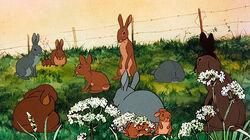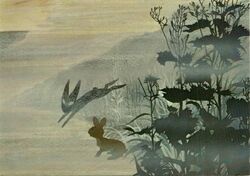
It gets totally violent, though.
- Rabbits (says Mr. Lockley) are like human beings in many ways. One of these is certainly their staunch ability to withstand disaster and to let the stream of their life carry them along, past reaches of terror and loss . . . an intuitive feeling that Life is Now.
- —Richard Adams, Watership Down chapter 22: 'The Story of the Trial of El-Ahrairah'
Watership Down is a novel by Richard Adams, detailing the journey of a band of rabbits from their home to find a new warren. All of the main characters are rabbits, and all the rabbits act very much like real rabbits, based on Adams's reading of The Private Life of the Rabbit by naturalist Ronald Lockley.
It is, perhaps, notoriously famous for its depictions of violence, especially in the movie adaptation, whose Disney-like animation style fooled parents into thinking it would be innocent enough to let young children view.
The Canon[]
- Novels: Watership Down (1972) and Tales from Watership Down (1996)
- Minor adaptations, including stage and radio plays.
- Film (1978)
- Stays close to the novel canon, other than making Woundwort blind in one eye.
- TV series (1999-2001)
- Introduces many new characters, locations, and the existence of outright magic; Blackberry is gender bent. Violence is toned down for public broadcast, until season three goes off the rails.
The Setting[]
The presentation of the rabbits in Watership Down is an interpretation of how prey animals might interact given a culture. Rabbits live in warrens, and work together to keep the group fed while avoiding getting eaten by 'elil,' predators. Unfortunately, a bit of human bias sneaked in on one detail: the warrens in the novel are all led by kings ('rahs'), although real rabbit warrens are actually matriarchal systems. The rah of a warren is served by the Owsla, large male rabbits (bucks) who work together to stand guard and fight off elil when possible. Does (female rabbits) are primarily tasked with digging and raising young.
Humans appear throughout the novel, considered by rabbits to be the most confusing of the elil. While most elil simply kill rabbits to eat, and can be battled in some situations, humans make strange things like snares and hrududil (automobiles) that can take a rabbit's life senselessly, and beyond any ability to fight back. On the other hand, they sometimes feed rabbits for no clear reason, and will even try to care for rabbits and elil on the same farm. They also put white sticks in their mouths and then set them on fire, which seems unsafe.
Rabbits speak Lapine to communicate. In-universe, it isn't entirely verbal, but includes body language, full pauses, and foot stamps as well as vocal sounds. It is unavoidably presented to the audience as human language, with certain words given in Lapine, such as rabbit names, rabbit-lifestyle-based concepts, and man-made objects rabbits don't understand. Plural nouns tend to end in -il. Rabbit names tend to be names of plants and other aspects of nature, although some names that translate into a complex concept in human language are left in Lapine rather than translated out every time. (One warren that only appears in the TV series has its residents all named after minerals rather than plants.)
Due to the incomplete nature of Lapine, it is almost impossible to construct complete sentences out of it. Invention of new words is often necessary in fanfiction.
There also exists Hedgerow, a 'common tongue' spoken by most animals, which the rabbits use to communicate outside their species. When speaking to the rabbits this way, the non-rabbits are presented as speaking in pronounced, phonetic accents. The one animal that rabbits are entirely unable to communicate with seems to be the human.
Some rabbits, like Fiver, have a preternatural ability to sense danger. They get usually ambiguous visions of things yet to come, or sometimes, see things happening elsewhere. In the TV series, it's part of the magic of the setting, but the novel and movie don't go out of their way to explain it.

The Black Rabbit of Inlé, in one of Fiver's visions.
In addition to the main timeline of the story, the rabbits often tell legends from a creation myth about the first leader of rabbits, El-Ahrairah (El-Ahrah in the TV show), who spread his people all over the world. To prevent rabbits from wiping out all plant life, the sun god Frith gave other animal species traits that transformed them into predators, giving El-Ahrairah the new title of the Prince with a Thousand Enemies. Not wanting rabbits to get wiped out themselves, however, Frith granted rabbits the ability to dig tunnels, and the cunning to solve any difficulties they encounter. Also related to these stories is the Black Rabbit of Inlé, the grim reaper figure for rabbits. Seen as being a servant of Frith's will, rather than openly malevolent, he takes rabbits to an all-stone warren hidden somewhere in the world when they stop running. The Black Rabbit's physical arrival on screen in the TV series blurs the question of whether this creation myth is its own subcontinuum, or actually a true part of the Watership Down world's history.
Watership Down in Fanfiction[]
Watership Down lends itself easily to original characters, especially rabbit ones, due to all the background rabbits seen throughout the series. Uncanonical relatives are common, especially children of the mated characters at the end of the story, or brothers of Hazel and Fiver that didn't appear in WD. Having Fiver's precognitive intuition is an easy way to become speshul, especially if the OC is descended from him or Hyzenthlay. However, considering those are the only two rabbits in the story said to have that sense, it clearly isn't common. Giving female canons and OCs more prominent roles could probably be forgiven in this fandom, considering how few and far between they are in canon, and the fact that Adams himself tried to 'fix' this lack in the sequel.
Most animals could easily serve as believable OCs as well, considering Hazel's policy of befriending non-aggressive ones; just watch for species not native to England. Humans are the one species most removed from the action in WD, but often appear in fanfiction as "falling into the book" or "magically turned into a rabbit" OCs. Any human character who can communicate in Lapine or Hedgerow is most likely a Mary Sue.
While many fics may need to make up words in Lapine, ones that contradict the few established rules for the language we do know are called Coney-Grelvish, and are charge-worthy.
Watership Down misspellings create mini-Woundworts.
Missions in this Continuum[]
- 'The Sacred Daughter', Agents Tawaki and Iskillion (DF)
- 'Say Hello, Wave Goodbye', Agents Grace Leon and Ally Malet (DF)
External Links[]
- Watership Down on Wikipedia
- Lapine on Wikipedia
- One example of a 'fan-completed' Lapine language
